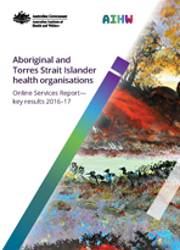Summary
This ninth national report provides information on 266 organisations funded by the Australian Government to deliver health services to Aboriginal and Torres Strait Islander people. These organisations contributed to the 2016–17 Online Services Report. Information is presented on the characteristics of these organisations; the services they provide; client numbers, contacts and episodes of care; staffing levels; and service gaps and challenges.
Some changes were made to the 2016–17 data collection, aimed at ensuring consistency in episode of care reporting between the different data collection systems. This resulted in a decrease in primary health episode of care counts in 2016–17. These are not comparable with previous collections, so comparisons are not presented in this report. See Chapter 2 for more information about the data collection, data quality and the impacts of these changes.
Key messages
1.A range of services are provided to Aboriginal and Torres Strait Islander people
Of the 266 organisations in 2016–17:
- 196 (74%) provided a range of primary health-care services to around 444,700 clients through 3.2 million episodes of care. Just over two-thirds of these organisations (136) were Aboriginal Community Controlled Health Organisations. Services provided include: health promotion; clinical care; substance-use treatment and prevention; and social and emotional wellbeing support. These organisations also provided access to specialist, allied health and dental services, either on site or by facilitating off-site access. For example, most provided access to cardiologists (90%); renal specialists (87%); ophthalmologists (86%); paediatricians (90%); psychiatrists (87%); diabetes specialists (90%); and ear, nose and throat (ENT) specialists (88%). They also provided access to dental services (94%) and to allied health services such as physiotherapists (89%); psychologists (93%); dieticians (95%); podiatrists (96%); optometrists (94%); and audiologists (91%).
- Around 7,600 full-time equivalent (FTE) staff were employed by organisations providing primary health-care services and just over half of all staff (53%) were Aboriginal and/or Torres Strait Islander (see Chapter 3).
- 213 (80%) provided maternal and/or child health services through their primary health and/or New Directions funding. Around 8,400 Indigenous women were seen through 42,200 antenatal visits—an average of 5 visits per client (see Chapter 4).
- 88 (33%) provided social and emotional wellbeing services. The 189 counsellors in these organisations saw around 16,300 clients, through 77,100 client contacts—an average of 5 contacts per client (see Chapter 5).
- 80 (30%) provided substance-use services to around 39,400 clients through 197,700 episodes of care. Most episodes of care (88%) were for non-residential or after-care services (see Chapter 6).
-
Many funded organisations provide services in Remote and Very remote areas
Nearly half (46%) of the organisations funded to provide primary health-care services to Aboriginal and Torres Strait Islander people did so in Remote or Very remote areas and they saw around 168,100 (38%) clients. Around 44% of employed staff (3,347 FTE) worked in Remote or Very remote areas, including a higher proportion of employed nurses and midwives (59% or 664 FTE) and a lower proportion of
employed dental care staff (21% or 38 FTE). There were more FTE nurses and midwives per 1,000 clients in Remote (3.5) and Very remote areas (4.4), compared with 2.6 per 1,000 clients overall. There were fewer doctors in Very remote areas (0.9 FTE doctors per 1,000 clients compared with 1.3 overall), perhaps reflecting a greater reliance on nurse-led clinics in these areas. Contacts by nurses and midwives represented half (51%) of all contacts in Very remote areas compared with 29% overall.
Over 800,000 episodes of care (25%) were provided to clients in Very remote areas. However, organisations in Very remote areas were still more likely to report staffing vacancies. Nearly one-third (31%) of reported health-staff vacancies were in organisations in Very remote areas. They also had more health-staff vacancies per 1,000 clients (1.0 compared with 0.7 overall). Organisations in Very remote areas were also more likely to report the recruitment, training and support of staff as one of the challenges they faced in providing quality care to clients (75% compared with 67% overall) as well as staff retention and turnover (75% compared with 57% overall).
3.Various group activities are run to promote health and wellbeing
Organisations delivered a range of group activities in 2016–17 to improve the health of the community:
- Those funded to provide primary health-care services ran around 8,400 physical activity/healthy weight sessions; 4,300 chronic disease client support sessions; and 3,300 tobacco-use treatment and prevention sessions. Other common health promotion activities included campaigns to encourage immunisation services (in 81% of organisations), healthy lifestyle programs (75%) and sexual health/ education (71%).
- With respect to maternal and child health services, around 20,300 home visits; 3,100 maternal and baby/child health group sessions; 2,100 parenting group sessions and 1,000 antenatal group sessions were provided.
- In those funded to provide substance-use services, most (93%) provided community education, while 60% did school visits. Around 4 in 5 (80%) ran physical activity or healthy weight programs and around three-quarters ran tobacco-use treatment and prevention groups (76%), alcohol-misuse treatment and prevention groups (74%), living skills groups (75%), men’s groups (75%) and women’s groups (74%).
Things to note
- Most (94%) organisations funded to provide primary health care also provided social and emotional wellbeing or mental health or counselling services, and over half (57%) had mental health promotion activities in 2016–17; however, nearly two-thirds of organisations still reported mental health and social and emotional wellbeing services as a service gap (63%). This was even higher (78%) in organisations funded to provide substance-use services, but not primary health care.
- Some organisations indicated that clients with high needs had to wait too long for some services, in particular to access dental services and mental health professionals. For example, 50 (27%) organisations providing on-site or off-site access to dental services still felt clients with high needs often had to wait a clinically unacceptable time for dental services. This was higher in organisations in Remote (44%) and Very remote (34%) areas.



